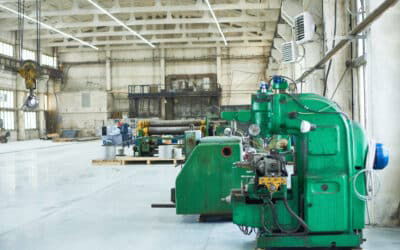The Measurement Trap
Walk into most modern factories and you’ll find the same scene: OEE dashboards on office walls, weekly performance reports in managers’ inboxes, and shift summaries neatly filed away. Everyone’s measuring overall equipment effectiveness. Few are actually driving OEE improvement.
Here’s the uncomfortable truth: measuring OEE doesn’t improve performance. It never has, and it never will. What improves manufacturing productivity is what you do with that measurement. And in most manufacturing facilities, the answer is: not much.
Data without action isn’t intelligence. It’s decoration.
Why Measurement Alone Doesn’t Drive Manufacturing Performance
The problem isn’t that factories don’t have OEE metrics. Most have plenty of them. The problem is when and how that data arrives, and how it connects to actual production process objectives.
Late Data Kills Equipment Effectiveness
OEE reports typically show up too late. End-of-shift summaries. Weekly production reviews. Monthly KPI meetings. By the time you’re looking at your OEE score, the opportunity to fix the problem has long since passed. When data arrives after the fact, it’s no longer information — it’s history.
Context Loss Creates Performance and Quality Gaps
The numbers are disconnected from context. A report shows your production line ran at 67% OEE on Tuesday. But why? Was it a quality issue? A material shortage? Equipment downtime that took 20 minutes to fix? Without the context, even comparing against OEE benchmarks becomes meaningless. And by Thursday, when you’re finally reviewing it, nobody remembers what actually happened.
Operators Need Actionable OEE Performance Data
Tell a line operator their availability score was 72% yesterday, and you’ll get a shrug. It’s just a number. It doesn’t tell them what went wrong, what they could have done differently, or what to watch for today. The metric becomes something that happens to them, not something they can control.
This is the measurement trap: collecting data that’s too late, too vague, and too disconnected from the people who can actually use it to achieve manufacturing goals.
Real-Time OEE in Manufacturing: From Insight to Action
Everything shifts when OEE becomes visible in real time. Not at the end of the shift. Not in tomorrow’s report. Right now, on the shop floor, when something can still be done about it.
How Equipment Availability and Preventive Maintenance Drive Results
Real-time OEE monitoring transforms data from a scorecard into a trigger for continuous improvement. Here’s what that looks like in practice:
|
Problem Detected |
Action Enabled |
Result |
|---|---|---|
|
Frequent micro-stops (big losses) |
Operator identifies root cause and adjusts process |
+10% equipment availability |
|
Reduced line speed (performance loss) |
Supervisor investigates and corrects parameters |
+7% performance score |
|
Quality rejects trending up |
Preventive maintenance intervenes before major issue |
+5% quality score |
|
Long changeover times |
Team visualizes setup sequence using lean manufacturing principles |
-20% production time lost |
This isn’t theoretical. This is what happens when the gap between “something’s wrong” and “let’s fix it” shrinks from hours to minutes. The impact on profitability becomes immediate and measurable against industry standards.
Reactive to Proactive: Lean Manufacturing and Maintenance in Action
The difference is simple but profound: reactive becomes proactive. Instead of analyzing yesterday’s losses, teams are preventing today’s. Instead of explaining why OEE performance dropped, they’re catching issues before they compound. This aligns perfectly with lean production objectives and productive maintenance strategies.
The New Daily Routine: OEE Performance as a Management Tool for Achieving Goals
With real-time visibility through OEE software, OEE stops being a report you review and becomes a tool you use. It changes the entire rhythm of how production teams work and allocate resources.
Operators follow their line performance throughout the shift on tablets, screens, or mobile devices. They see when availability drops, when cycle times drift, when quality issues emerge. Most importantly, they see it while it’s happening, not after their shift ends. This visibility drives progress toward achieving world-class OEE.
Team leaders discuss losses at the end of each shift, not vague impressions of how the day went, but actual data points. “We lost 45 minutes to material delays” becomes “How do we prevent that tomorrow?” The conversation shifts from blame to solutions, with clear goals for the next production cycle.
Managers prioritize actions based on real losses, not gut feelings. Should you invest in that new changeover procedure? The data shows it’s costing you 8 OEE points per shift. Should maintenance focus on Line 3 or Line 5? The performance calculation tells you exactly where the biggest impact lies on the productivity of manufacturing equipment.
Production becomes piloted by facts, not by impressions. And facts, when they’re timely and clear, drive better decisions and enhance customer satisfaction through consistent quality.
The best factories don’t review OEE at the end of the week — they fix it before lunch.
Case Example: From Numbers to Results
A packaging line in the food industry had been tracking OEE manually for months. Their average hovered around 68%. Not terrible when compared to basic benchmark standards, but far from high OEE performance. The numbers came from shift logs, entered into spreadsheets, reviewed in weekly meetings.
When they implemented PerfTrak with real-time monitoring, something unexpected happened within the first week. The system flagged a recurring 5-minute stop that appeared on every second batch. It had been invisible in the daily averages, lost in the noise of dozens of other small issues affecting their manufacturing process.
The operator recognized it immediately: a poorly designed material feed that required manual adjustment between product sizes. The fix took 30 minutes and cost nothing — just repositioning a guide rail and eliminating unnecessary rework.
Result: +8 OEE points. ROI in less than a month.
The data had always existed. The problem had always existed. What changed was visibility. And visibility enabled action. This example demonstrates how OEE KPIs become actionable when measured correctly using the right OEE formula approach.
This pattern repeats across industries. The problems aren’t usually massive machinery failures or fundamental process flaws. They’re small, recurring issues that compound over time. Issues that are only obvious when you can actually see them happening.
Continuous Improvement: The OEE Performance Loop
Here’s what separates factories that measure OEE from factories that improve it: they understand that improvement isn’t a project with an end date. It’s a continuous loop aligned with lean manufacturing principles.
Measure → Capture real-time performance data across all three OEE components
Understand → Analyze losses by category, frequency, and impact on time production target
Act → Implement targeted fixes based on data, not assumptions
Improve → Track the impact of changes in real time against your manufacturing performance objectives
Measure again → Continue the cycle with new baseline
This cycle doesn’t happen quarterly. It happens daily, sometimes hourly. Each turn of the loop builds on the last. Small improvements compound. Processes that were losing 5 minutes per cycle lose 3, then 2, then 1.
The key is that the loop only works when measurement is fast enough to support action. Monthly reviews create monthly cycles. Real-time data creates continuous improvement.
Most factories get stuck at step one or two. They measure, maybe they understand, but the gap to action is too wide. By the time they’ve identified a problem, analyzed it, scheduled a fix, and implemented it, new problems have piled up. They’re always running behind.
Real-time OEE monitoring collapses that gap. The loop spins faster. Problems get smaller. Teams get better at spotting patterns. Improvement becomes the default, not the exception.
OEE Data Belongs on the Shop Floor, Not in Spreadsheets
Let’s bring this back to where we started. You can measure OEE all you want. You can calculate it to three decimal places using every variation of the OEE formula. You can put it in beautiful graphs and present it to senior leadership.
But none of that matters if the people running your lines can’t see what’s happening in time to do something about it.
OEE improvement doesn’t come from better spreadsheets. It comes from operators who can spot a problem forming. Team leaders who can respond while it still matters. Managers who can prioritize based on real losses, not educated guesses. This is where efficiency meets execution in the manufacturing process.
The data has to be where the action is: on the shop floor, in real time, in the hands of the people who actually make things.
PerfTrak was built for this exact reality. Not for generating reports, but for driving improvement. Not for analyzing history, but for changing what happens next on your production line.
Ready to turn your OEE data into real improvement? See your performance in action with PerfTrak, where measurement meets momentum and equipment effectiveness drives results.
Book a live demo and discover the hidden OEE losses destroying your yield and profitability.





0 Comments